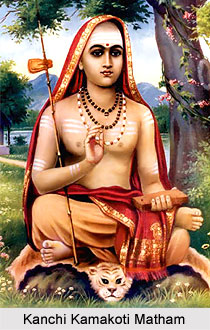 At the times of the fading devotional practices among people the advent of Sri Sankara took place to revive the faith in religion and reestablish faith in the Almighty.In a place called Kaladi in Kerala the auspicious birth of Sri Sankara occurred. After his upanayanam ceremony Sankara lived with his guru to learn and master the Vedas. Sankara apart from being a great scholar and preceptor was a national integrator at very early period of India`s history.
At the times of the fading devotional practices among people the advent of Sri Sankara took place to revive the faith in religion and reestablish faith in the Almighty.In a place called Kaladi in Kerala the auspicious birth of Sri Sankara occurred. After his upanayanam ceremony Sankara lived with his guru to learn and master the Vedas. Sankara apart from being a great scholar and preceptor was a national integrator at very early period of India`s history.
In his early life he resolved to enter the sanyasa asrama and serve the people renouncing worldly pleasures. Despite being an avatar of Lord Siva himself Sri Sankara searched for a guru and took his regular sanyasa from Govinda Bhagavadpada. Sankara`s yatra to Kailasa, the abode of Siva, is one of the notable events in the life of the Acharya. Pleased with Sankara`s payers Lord Siva blessed him with five sphatika (crystal) lingas and instructed him to arrange for the worship of these lingas for the welfare of mankind. Sankara received from the Lord the rules about the mode of worship and a palm leaf manuscript of Soundarya Lahrari which is Siva`s own hymn in praise of Parasakthi.
It is learnt from information available, that Sankara placed one of the lingas, known as the Mukthi Linga in the temple of Kedarnath and the Vara Linga at Neelakanta Kshetra in Nepal. The Bhoga Linga was placed in Sringeri Sarada peetham in Karnataka and the Moksha Lingam was sent to the Nataraja temple at Chidambaram. He kept the Yoga Linga for his own personal worship and for his successors at Kanchi.
When Sankara arrived at Kanchi, the people of Kanchi under the leadership of king Rakasena welcomed him. Sankara consecrated the Srichakra before Devi Kamakshi and number of ancient Sanskrit manuscripts confirms this as well as the fact that he attained his siddi there. In the Kanchi Kamakshi temple there is the stone icon indicating the place where he attained siddbi.
After his digvijaya tours Sri Sankara settled down in Kanchi, gave sanyasa deeksha to a young boy Sarvajnatman, nominating him as his successor as the Acharya of Kanchi. Some of the famous Acharyas to have adorned this post are Sri Kripa Sankara, Sri Abhinava Sankara, Sri Bhodhendra Saraswathi and the world renowned 68th Acharya Sri Pujyasri Chandrasekharaendra Saraswathi Swamigal. Adi Sankara took to sanyasa directly from Brahma-charya ashrama. The same order is being followed till now where the head of the matham is selected from brahmacharis only. The Acharyas of Kamakoti Peetham have the title "Indra Sarasvati" and the Acharyas themselves perform the trikalapooja for Sri Chandra -moulishwara deity.
The name of Sri Sankaracharya is found only in the official seal of Kanchi Kamakoti Matha. The word KanchidivyaKshetre and the phrase Srimacchankara - Bhagavatpada-calyanam adhithsne in the briduvali indicate Sankara`s siddi at Kanchi. The Kanchi Peetham was thus nucleus for safeguarding our ancient Veda-Ashrama and for the propagating of Advaita discipline.



















